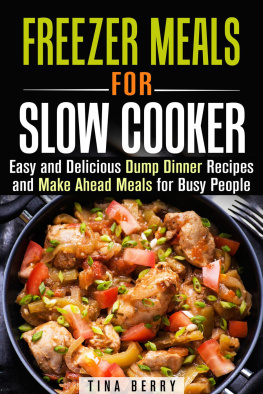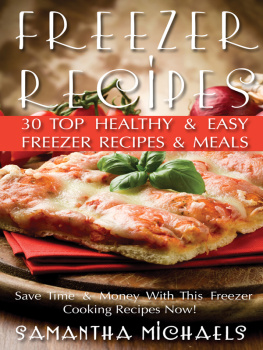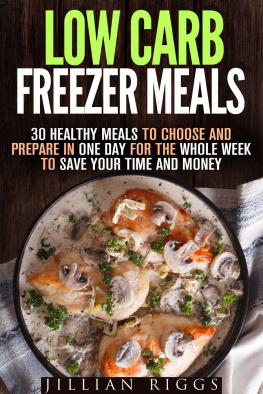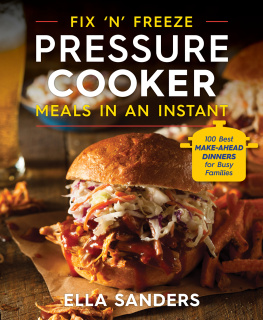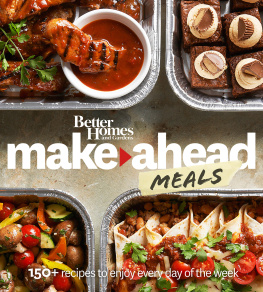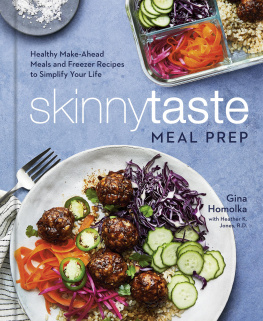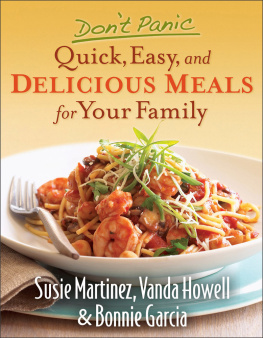CONTENTS
CHAPTER 1
GETTING STARTED
CHAPTER 2
CASSEROLES
CHAPTER 3
MEATS
CHAPTER 4
POULTRY AND SEAFOOD
CHAPTER 5
SOUPS, STEWS, AND CHILIS
CHAPTER 6
SIDE DISHES AND VEGETARIAN OPTIONS
CHAPTER 7
BREADS, ROLLS, PIZZAS, AND MORE
CHAPTER 8
APPETIZERS
CHAPTER 9
SAUCES, CONDIMENTS, AND OTHER STAPLES
CHAPTER 10
BREAKFASTS
CHAPTER 11
DESSERTS
CHAPTER 1
GETTING STARTED
ALL YOU NEED TO KNOW FOR FANTASTIC
FREEZER-FRIENDLY MEALS

IN TODAYS BUSY WORLD, families sitting down at the table for home-cooked meals is a rarity. Frequently, meals are eaten at restaurantsor too often from the drive-thruor from meals pulled from the supermarket freezer section and reheated in the microwave. The result of too many meals out and overconsumption of processed, packaged foods is families who are overweight; a growing number of children suffering from chronic weight-related diseases, such as type 2 diabetes; and a disconnect of families from the enjoyment of sit-down meals made (even mostly) from scratch.
Eating out, dining by delivery, drive-thrus, and grocery store frozen main courses not only put your health and waistline at risk, but they are expensive and in many cases, take just as much time, if not more, than cooking a meal at home. Gathering your family around the kitchen dinner table or even better, having the family help with the meal before it gets to the dinner table, is a tasty opportunity to spend quality time together. Best yet, by making meals at home, you are teaching your kids a valuable lesson in health-promoting, money-saving life skills. Your kids will grow up with the perspective that home-cooked meals are the normeven for the busiest of families.
So how do you accomplish healthfully feeding your family every day without spending most of your day slaving in the kitchen? By learning the art of make-ahead meals! Fixing and freezing meals is an easy, cost-effective, and long-term solution to keeping your family well-fed at home as well as on-the-go.
As you page through this book, youll find recipes ranging from eye-opening breakfasts and comfort food casseroles to succulent meats and lip-smacking sweetsall of which can be frozen and reheated effortlessly, yielding meals that are not just as tasty as meals made on the spot, but even better, given the time theyve been given (in the freezer) for their flavors to mingle and develop.
In addition to recipes for all tastes and occasions, youll find guidelines for successfully fixing and freezing meals, both for individual servings and for feeding a crowd, as well as detailed reheating and serving suggestions for every single recipe.
Make-ahead meals do require some time up front, but the result is a future of delicious, stress-free meals that can be put on the table in a manner of minutes. Ready to get cooking?
FIX-AND-FREEZE 101
Fixing and freezing your own selection of ready-to-heat eats is a simple and easy process to master, no matter what your level of freezing expertise. Here is all you need to know to get startedin just nine easy steps!
Step #1: Stay Well-Stocked
Keeping your kitchen stocked with essential ingredients will help ensure you can put together a healthy mealwhether it is make-ahead or notwithout having to run to the store. Staple ingredients are nutritious, packed with flavor, and endlessly versatile.
TEN STAPLES FOR THE HEALTHY MAKE-AHEAD KITCHEN
1. Canned Beans
A stellar source of protein, fiber, and other health-promoting nutrients, canned beans are one of the most versatile ingredients in the kitchen. They have a long shelf life and as an ingredient in make-ahead recipes, do well in the freezer.
TASTY AND CREATIVE USES FOR CANNED BEANS
Pured for dips, such as hummus Used as a thickener for sauces Tossed into salads for a meat-free protein alternative Simmered in soups, stews, and chili Added to burrito and enchilada fillings Used as a base for vegetarian burgers
2. Frozen Fruits and Vegetables
A daily trip to the supermarket for fresh produce isnt feasible for most busy families. Keeping a variety of frozen fruits and vegetables on hand not only gives you a convenient way to include nutrient-rich produce in your weekly meals, it also keeps a ready supply of healthy ingredients to add to your fix-and-freeze feasts. Some of my favorite frozen fruits and vegetables to keep on hand include: Blueberries, marionberries, mango, sliced bananas (you can easily package these yourself), peas, corn, edamame, lima beans, and mixed vegetables.
3. Dry Pasta, Rice, and Other Grains and Flours
The palate-pleasing plethora of whole-grain pastas, rice, and other grains such as quinoa, millet, and barley give you a near endless array of wholesome ).
Opt for high-fiber pastas, whole-wheat couscous, brown or wild rice, and the many whole grains you can find in the bulk section of your local natural food stores or in the grain aisle at the supermarket. In addition, keep a bag each of whole-wheat pastry flour and all-purpose flour for baking, breading, and thickening.
4. Olive or Canola Oil
No kitchen pantry should be without at least one heart-healthy cooking oil. Both olive and canola oils are rich in good-for-you monounsaturated fats and can be used for a variety of culinary applications. Because of its delicate nature, extra-virgin olive oil should only be used for salad dressings or to drizzle on cooked foods, while pure olive oil can withstand higher heat cooking, such as sauting. Canola oil has a very mild flavor, which is ideal for many baked goods, and can also be used in higher-heat cooking.



